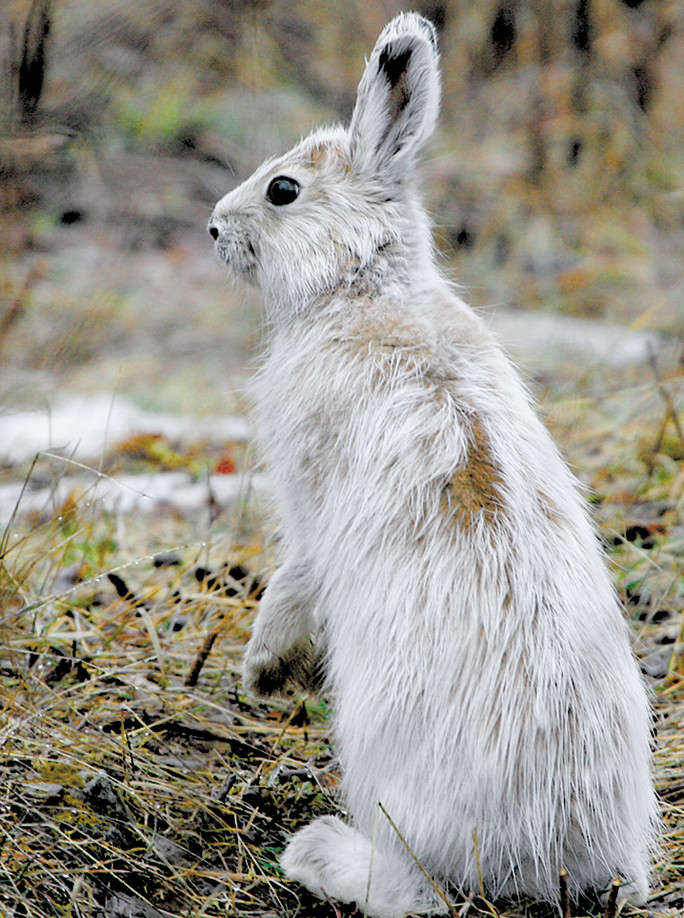Support the Timberjay by making a donation.
For snowshoe hares, it’s time for a change
It’s that season of change for our native bunnies, otherwise known as snowshoe hares.
With the snow (finally) fading away, the snowshoe hares are quickly shedding their winter coat of white as …
This item is available in full to subscribers.
Attention subscribers
To continue reading, you will need to either log in to your subscriber account, or purchase a new subscription.
If you are a current print subscriber, you can set up a free website account and connect your subscription to it by clicking here.
If you are a digital subscriber with an active, online-only subscription then you already have an account here. Just reset your password if you've not yet logged in to your account on this new site.
Otherwise, click here to view your options for subscribing.
Please log in to continue |
For snowshoe hares, it’s time for a change
It’s that season of change for our native bunnies, otherwise known as snowshoe hares.
With the snow (finally) fading away, the snowshoe hares are quickly shedding their winter coat of white as well.
While these common hares have a number of adaptations that allow them to survive, their seasonal change of color is probably the most noticeable, and it’s one that can pose problems for a species that is a highly desirable meal for just about every predator in the forest. In a year like this, with lingering snow cover, switching to summer brown too early can leave a snowshoe hare more of a target. But that problem goes double for years when the snow leaves in March, leaving a hare still in winter white feeling truly exposed. It’s the same thing in November if the snow comes later than usual.
A lot of wildlife undergo various seasonal changes and, as with the snowshoe hare, these changes are frequently related to day length, or photo-period. As day length changes, it affects hormones within the hare that alter its production of melanin, which is the same chemical that affects skin color in humans. As days lengthen, the hare produces more melanin, which turns its coat brown. As the days shorten in the fall, melanin production drops off and the coat turns white.
This could pose challenges for snowshoe hares if climate change significantly alters the amount of snow cover throughout its range. Indeed, recent studies suggest that snowshoe hare populations on the southern edge of their range may be declining fairly significantly. That probably won’t happen here, at least for a few more years. Hare populations remain pretty robust in our area these days, as their tracks in the snow attested around our house this winter.
While these hares can be tough to spot in their winter white, their distinctive tracks are easy to find. This species got its name from its unusually large back feet, which act like snowshoes, allowing these hares to stay on top of all but the most-powdery snow.
This ability not only allows them to more effectively escape predators, it also provides them new feeding opportunities as the snowpack increases, giving them higher and higher access to the bark of branches, twigs, and woody stems that they feed on over the winter.
With the snow now disappearing, the hares are already turning their attention to the breeding season. Snowshoe hares don’t raise their young underground, like old world rabbits. Instead, they create nests in small depressions, usually in thick brush. And unlike rabbits, which are born naked and only partially developed, young hares are born fully-furred, with eyes open. Give them an hour or two, and they’re ready to scamper off through the woods.
Identifying a snowshoe hare in our region is usually pretty easy, winter or summer. This is the only species of hare or rabbit normally found here in the north woods. Cottontail rabbits, which are found in southern and central Minnesota (my mother has them in her yard in Grand Rapids), remain all but unknown in our region, although that’s probably changing.
The snowshoe is the smallest member of the genus Lepus, which includes other hare species, like jackrabbits. While most hares are generally solitary (except during breeding season), snowshoe hares do occasionally gather in large groups. I once encountered such a group near Pfeiffer Lake, back in 1979 when our region experienced a huge spike in the hare population. While driving leisurely on a forest road near the lake, a snowshoe hare hopped out onto the road right in front of me. I stopped and as I did, a second hare hopped out of the woods, and then a third and a fourth, and pretty soon I had more than a dozen hares surrounding my car. Some of them starting standing up on their hind legs like they were trying to look inside the car. I know, it sounds like some cheap horror flick or an acid trip, but it really happened. I must have sat there for 20 minutes wondering if I’d entered the Twilight Zone before they eventually grew bored with me and disappeared back into the woods.
It was interesting to be sure, and it left me wondering what other strange things those snowshoe hares just might be up to way out in the woods. Animals, after all, never cease to surprise us.






